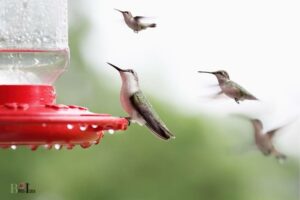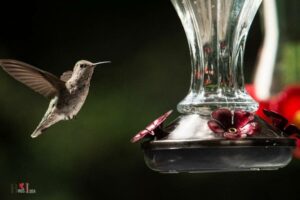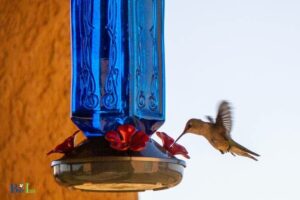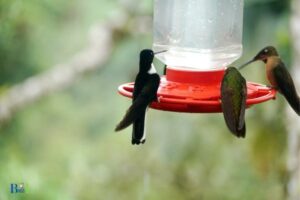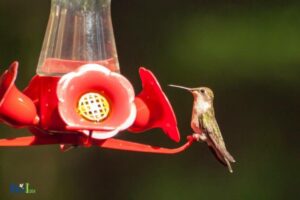My Hummingbird Feeder is Cloudy: By Bacteria!
A cloudy hummingbird feeder is usually caused by bacteria or mold growth due to uncleanliness or over-fermented sugar water.
Hummingbird feeders provide a valuable source of nectar for these tiny birds, but they can easily become dirty and cloudy when not properly maintained. The cloudiness in the hummingbird feeder is often a result of bacteria or mold growing in the sugar water mixture.
This happens when the feeder is not cleaned regularly, or if the sugar water has been left out for too long, allowing it to ferment and become a breeding ground for microbes.
Additionally, replace the sugar water mixture every 2-3 days to prevent fermentation and the growth of harmful bacteria or mold. This will help keep the feeder clean and clear, providing a healthy food source for the hummingbirds.
5 Causes of Cloudiness in My Hummingbird Feeder
| Causes of Cloudiness | Solutions | Maintenance Tips |
| Bacterial growth | Clean and sanitize the feeder regularly | Change nectar every 3-5 days |
| Mold formation | Replace old nectar with fresh nectar | Clean the feeder with a brush specially designed for hummingbird feeders |
| Yeast contamination | Use a bleach solution to sanitize the feeder | Rinse the feeder thoroughly with hot water after cleaning |
| Sugar residue | Clean the feeder with a mild dish soap | Avoid overfilling the feeder to reduce sugar build-up |
| Mineral deposits | Soak the feeder in a white vinegar solution | Use distilled or filtered water in the nectar solution |
Key Takeaway
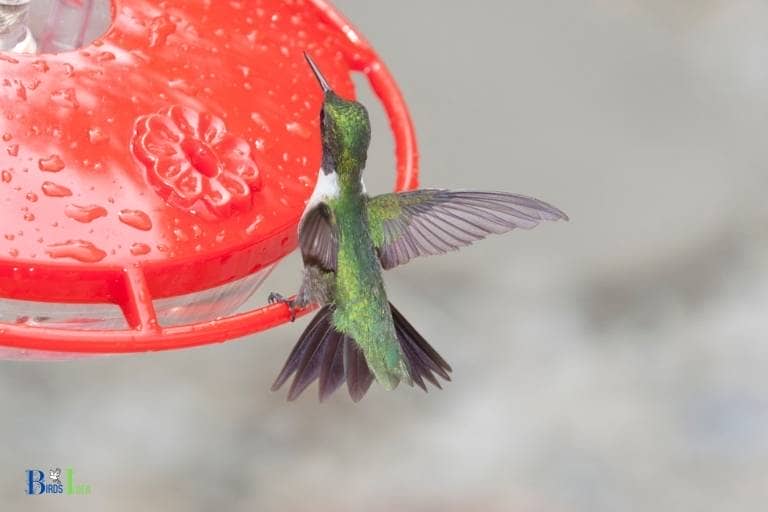
Five Facts About: Cloudiness in Hummingbird Feeders
The Science Behind Cloudy Hummingbird Feeder Solution
My Hummingbird Feeder Is Cloudy
Hummingbirds are one of nature’s most beautiful creations. They bring joy and wonder to all who have the privilege of seeing them up close. One of the ways many people enjoy watching these amazing creatures is by setting up hummingbird feeders in their backyards.
However, when the feeder’s solution becomes cloudy, it can cause concern and frustration. In this blog post, we will explore the science behind cloudy hummingbird feeder solution and provide solutions to make sure your feeder remains clear.
Causes Of Cloudy Hummingbird Feeder Solution
If your hummingbird feeder solution is cloudy, there could be a number of reasons why.
Some of the most common causes of cloudy hummingbird feeder solution include:
- Sunlight exposure: When hummingbird feeders are exposed to direct sunlight, the sugar solution inside can begin to darken and become cloudy. This is because the heat from the sun causes the sugar molecules to break down, resulting in the formation of a dark-colored substance.
- Dirty feeder: Hummingbird feeders need to be cleaned regularly to prevent the growth of harmful bacteria and mold. If the feeder is not cleaned properly, the sugar solution can mix with these contaminants, resulting in cloudiness.
- Old solution: If the sugar solution in your hummingbird feeder is old, it can become cloudy over time. This is because the sugar molecules break down and form a dark-colored substance.
- Low-quality sugar: Not all sugar is created equal. Some types of sugar can lead to cloudiness in hummingbird feeders. It’s important to use high-quality sugar to avoid this issue.
Understanding The Importance Of Clear Hummingbird Feeder Solution For Hummingbirds
Maintaining a clear hummingbird feeder solution is important for the health and well-being of the hummingbirds that feed from it.
Here are a few reasons why:
- Hydration: Hummingbirds require a lot of sugar water to stay hydrated. If the solution in your feeder is cloudy, it may deter hummingbirds from drinking from it, leading to dehydration.
- Nutrients: The sugar solution in hummingbird feeders provides vital nutrients for hummingbirds. Cloudy solution can indicate that the solution is old and has lost its nutrient value, which can negatively affect hummingbirds’ health.
- Behavioral changes: Hummingbirds are very sensitive to changes in their environment. If you change the quality or clarity of their sugar water, it may cause changes in their feeding habits or migration patterns.
Keeping your hummingbird feeder solution clear is crucial for the health and well-being of these beautiful birds.
By understanding the causes of cloudy solution and the importance of clear solution for hummingbirds, you can ensure that your feeder remains a safe and inviting place for them to visit.
Common Mistakes While Preparing And Maintaining Hummingbird Feeder Solution
My Hummingbird Feeder Is Cloudy
Hummingbirds are a beautiful sight to see in any garden, but it’s important to keep their feeders clean and filled with the right solution.
Often, people face the problem of cloudy feeders which can harm the little birdies over time.
Let’s discuss some of the common mistakes while preparing and maintaining a hummingbird feeder solution.
The Importance Of Cleanliness While Preparing Your Solution
Hummingbirds are very sensitive to the taste and smell of their solution. Any scent other than sugar or soap can make them reluctant to feed, and dirty solutions can be harmful to their health.
Therefore, it is crucial to take extra care while preparing the solution.
Here are some key points to consider:
- Your container and utensils should be clean and sanitized before you prepare the mixture.
- Boil the water before adding sugar to it.
- Mix the sugar and water in a one-to-four ratio.
- Stir the mixture well to make sure all the sugar has dissolved.
- Add a small amount of unscented, clear dish soap to the mixture to keep it from going rancid too quickly.
- Rinse your feeder thoroughly every time you refill it.
Tips For Proper Mixing Of Solution
Getting the mixture right is critical to keep hummingbirds coming back to your feeder.
Here are some tips to keep in mind while mixing the solution:
- Use white granulated sugar to make the mixture.
- Do not use honey, brown sugar, or molasses as they can be harmful to hummingbirds.
The Importance Of Regular Feeder Cleaning
My Hummingbird Feeder Is Cloudy
Hummingbirds are a delightful addition to any backyard, and providing them with a feeder is an excellent way to ensure they stick around. However, if you notice that your feeder is getting cloudy, it’s crucial to take action immediately.
Maintaining a clean feeder is vital for the health of the birds, and it also ensures that they keep returning to your yard year after year.
Tips For Identifying When Cleaning Is Necessary
It’s essential to keep an eye on your hummingbird feeder so you can promptly identify when cleaning is necessary.
Here are some tips to help you determine when it’s time to clean:
- Check the nectar- if the nectar is cloudy or has a foul smell, it’s time to clean.
- Look for mold- if you see mold growth inside the feeder, it needs cleaning.
- Observe the birds- if the birds are not using it as frequently as before, there may be an issue with the feeder that needs attention.
The Risks Of Not Cleaning Your Feeder Regularly
Failure to clean your feeder regularly could pose serious health risks to the hummingbirds, and here’s why:
- Bacteria growth: When leftover nectar ferments, it becomes acidic, which in turn promotes bacterial growth. If the birds consume the fermented nectar, they could develop a fungal infection, which might be fatal.
- Mold growth: Hummingbird feeders are susceptible to mold growth, especially in warmer weather. The birds could become sick or die if they consume the mold-contaminated nectar.
- Sugar build-up: When the sugar in the nectar remains in the feeder for an extended period, it can coagulate and harden, making it almost impossible to clean. This buildup can lead to the growth of bacteria and mold.
Maintaining a clean feeder is crucial for the health of the birds and ensures they continue to visit your backyard. Follow these simple tips to keep your feeder clean and hummingbirds healthy.
Steps To Clean Your Cloudy Hummingbird Feeder
My hummingbird feeder was once the talk of the town with a steady stream of these tiny winged creatures hovering around it.
But lately, i have noticed that the feeder has become cloudy and dirty, and the hummingbirds no longer seem interested.
Cleaning the feeder is the obvious solution, but i wasn’t sure how to do it right. If you are struggling with the same issue, here are some steps to help you clean your cloudy hummingbird feeder and get it back to its former glory.
Material Required:
Before you start cleaning your hummingbird feeder, it’s essential to gather the right materials.
Here’s what you’ll need:
- White vinegar
- Hot water
- Dish soap
- Bottle brush or a small scrub brush
- Paper towels or a clean cloth
Cleaning Procedure Step-By-Step:
- Disassemble the feeder:
Carefully disassemble your hummingbird feeder, separating all the parts. Check each piece to make sure there are no cracks or damages, and set them aside for cleaning.
- Soak the parts:
In a large bowl or bucket, prepare a solution of hot water and dish soap. Add two tablespoons of white vinegar to the solution and mix well. Soak each part of the feeder in this solution for at least one hour.
- Scrub the parts:
Using a small scrub brush or a bottle brush, gently clean the inside and outside of each piece. Pay extra attention to the hard-to-reach corners where mold or dirt accumulates. Use paper towels or a clean cloth to wipe the parts dry.
- Clean the feeder ports:
Clean the feeder ports separately with a pipe cleaner or a small brush. Insert the tool inside each port and gently move it back and forth to remove any blockages.
- Reassemble the feeder:
Once you have cleaned and dried all the parts, you can now reassemble the feeder carefully. Make sure every piece fits snugly and securely. Add fresh nectar to the feeder and hang it back in its original location.
By following these simple steps, you can clean your hummingbird feeder and get it back to its pristine condition. Repeat this cleaning process every few days or once a week, depending on the weather and feeding frequency.
A clean and fresh hummingbird feeder will not only attract more birds but also keep them healthy and happy.
Additional Tips For Cleaning And Maintaining Your Feeder
My hummingbird feeder is cloudy: additional tips for cleaning and maintaining your feeder
Hummingbirds are fascinating creatures that can mesmerize anyone with their quick movements and vibrant plumage.
If you are one of the people who enjoy watching hummingbirds, you already know the importance of keeping your hummingbird feeder clean and well-maintained. A cloudy feeder can be a source of frustration, and it can even harm the birds if not taken care of properly.
In this section, we will provide you with additional tips on cleaning and maintaining your feeder, to help you keep your feeder crystal clear and your hummingbirds happy.
Factors To Consider When Selecting A Hummingbird Feeder
My Hummingbird Feeder Is Cloudy
Hummingbirds are incredible creatures that bring joy and color to our gardens. As a hummingbird feeder owner, one of the most frustrating problems you might have encountered is a cloudy feeder. Fortunately, this problem is fixable and preventable.
This post will elaborate on some of the factors to consider when selecting a hummingbird feeder to help you avoid this issue in the future.
Choosing A Feeder That Is Easy To Clean
If you’re a bird enthusiast, you know that cleaning your bird feeders is essential. Therefore, it’s vital to select a feeder that is easy to clean to avoid cloudy or contaminated nectar.
Here are a few things to consider:
- Choose a feeder with a removable base. This design makes it easy to clean the nooks and crannies.
- Opt for a feeder with a wide mouth design. A large opening makes it easier to access and clean the interior of the feeder.
- Avoid feeders with intricate design features, such as decorative feeding stations that can trap dirt and debris.
Opting For Feeder With Quality And Durability
Hummingbird feeders can come in a wide range of designs, materials, and prices.
Here are a few things to consider before making your purchase:
- The best feeder is one that is constructed with high-quality materials, such as glass or stainless steel, to ensure durability.
- Avoid purchasing inexpensive plastic feeders. They can deteriorate quickly.
- Make sure that the feeder has a sturdy hanging mechanism that is safe for the birds.
Ensuring The Feeder Is Free Of Chemicals
Many hummingbird feeders contain components made with chemicals that can harm birds. Therefore, it’s essential to ensure that the feeder you choose is free of harmful substances.
Here’s what to look for:
- Avoid feeders with paint coatings and decals as they may contain toxic chemicals that can harm hummingbirds.
- Select a feeder made with safe materials, such as glass or food-grade plastic.
- Look for labels on the feeder that indicate it is free of bpa and phthalates.
Selecting the right hummingbird feeder can make all the difference in ensuring that your feeder remains clean, clear, and healthy for hummingbirds. Remember to choose a feeder that is easy to clean, durable, and free of chemicals.
By following these tips, you can ensure that your feeder remains a safe and enjoyable spot for hummingbirds to feed.
Tips For Transitioning Your Hummingbirds To A New Feeder
Building Trust With New Feeder
When introducing a new hummingbird feeder, it is important to build trust with your feathered friends.
Here are some tips to help you do that:
- Hang the new feeder near the old one so that the hummingbirds can easily locate it.
- Fill the new feeder with nectar made from the same formula as the old feeder. This will help to ensure consistency and familiarity.
- Don’t remove the old feeder immediately. Leave it up for a few days so the hummingbirds can adjust to the new one gradually.
- Be patient. It may take hummingbirds a few days to find and use the new feeder.
Avoiding Common Mistakes When Introducing A New Feeder
Introducing a new hummingbird feeder can be tricky, and there are a few common mistakes that people make.
Here’s what to avoid:
- Don’t change the location of the feeder. Hummingbirds are creatures of habit, so keeping the location consistent will help them find the new feeder.
- Don’t fill the new feeder with red-colored liquid. Hummingbirds are attracted to the color red, but they will recognize the formula of the nectar, not the color.
- Don’t use soap or other chemicals to clean the new feeder. These can be harmful to the birds.
Maintaining Consistency During The Transition
Maintaining consistency is crucial when transitioning hummingbirds to a new feeder.
Here are some tips to keep things consistent:
- Use the same formula for the nectar in the new feeder as the old feeder.
- Fill the new feeder only halfway to start. This way, you can easily switch back to the old feeder if the birds aren’t using the new one.
- Keep the feeding schedule consistent. Hummingbirds rely on a consistent food source to survive, so don’t leave the feeders empty for long periods.
By following these tips, you can introduce a new hummingbird feeder successfully and keep the birds coming back for more delicious nectar. Remember to be patient and keep things consistent throughout the transition.
FAQ On My Hummingbird Feeder Is Cloudy
What Causes Cloudiness In Hummingbird Feeders?
Does A Cloudy Feeder Harm The Hummingbirds?
How To Clean The Cloudy Feeder?
How Often Should The Feeder Be Cleaned?
Conclusion
In case you’re facing problems with a cloudy hummingbird feeder, try the tips mentioned above like cleaning the feeder frequently and using fresh nectar.
Maintaining a healthy and hygienic environment for the birds is essential, and a clean feeder ensures that the hummingbirds have a healthy and nutritious source of food.
A cloudy feeder can be a result of bacterial growth, which can harm the birds and deteriorate the quality of the nectar. If the feeder is left uncleaned for an extended period, it can also attract insects like bees, which may prevent hummingbirds from feeding.
Therefore, it’s advisable to follow a regular cleaning routine and maintain the feeder’s hygiene to keep the birds healthy and coming back for more. Happy hummingbird watching!

